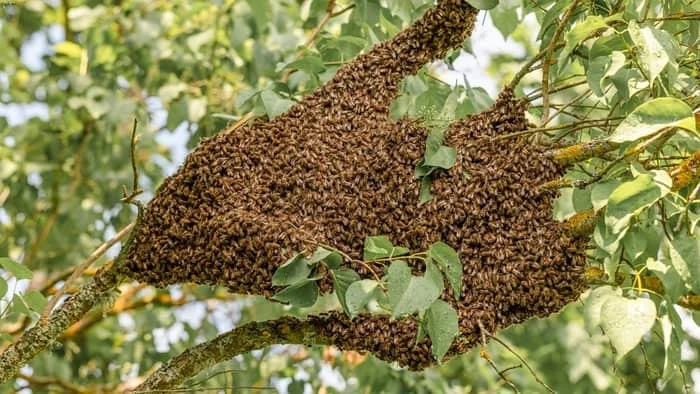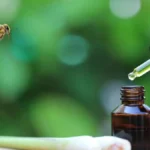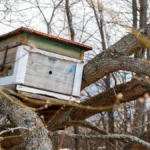For many of us, we start beekeeping wondering how to lure bees into a hive? Here we look at how to attract bees to a hive. Attracting bee swarms is easy, and with these tips, you will quickly understand how to get bees to move into a hive.
How To Lure Bees Into A Hive?
Attracting bee swarms is easy if we work on this very simple principle. You are the landlord and you have a property. You want the bees to be your tenants and you will charge them, honey, for rent. If you are a really cool landlord you may move them around a bit so they can travel to new places and work there too.
Location Location Location
Anybody in real estate will always tell you this. If you want to get tenants, make sure your property is in the right place. Now to understand what a good location is, we need to have a quick look at how a swarm decides where it is going to nest.
When A Swarm Leaves Its Hive
We have looked at the events that lead up to queen rearing and how this can cause a swarm. If a beekeeper nearby, or even you, did not get this stuff right, there will be a swarm floating around.
Cluster On A Bush Near Mother Hive
When bees leave a hive as a swarm, they will pour out of the hive and the queen will fly out too. They will mill around for a while, and then they move to a spot normally about 50 to 100 yards from the hive where they will settle in a big ball normally hanging from a branch or twig.

Leaving – Fast
They will regroup here. At this stage, bees do not normally scout for a new hive. If there is a very strong honey flow they will. But normally they will fly away around midday the next day and settle somewhere at least 5, but up to 20 or more miles away depending on race.
I have once or twice had the privilege of jogging in a swarm. We ran at full pace for about three miles – at this point, I was exhausted and the swarm pulled together, lifted high into the air, and just left me behind. When bees leave, they do it properly.
Settling
When they have flown far enough, they will suddenly slow down, and just zoom onto a tree branch, or into a shrub. They will hang here for the night and the next day scouting begins.
Scouting For Food
Some bees wake up early and go out and find flowers. This gives them an indication of the suitability of the new area. If there is lots of nectar present, they will go to the next stage. If not, they will fly away again and try to find a place with lots of food. Once they find this place, they progress to the next step.
Scouting For A New Nesting Site
Bees start their scouting for a nesting site quite early in the day. Scout bees will fly out and start looking quite high up – typically at least ten yards above the ground. This is a good place to start looking because of some of the following reasons. Irritating humans are not good at climbing trees and are less likely to bother them here. Most other bee pests also struggle to get up high in trees. It is a bit warmer up there as well.
When the scouts find a nesting site, they will walk around inside it and measure its volume quite accurately. Typically they are looking for a space of at least 5-14 gallons. This does not mean they will settle for a smaller or bigger place. If they happen to find a space of this size, the decision is easy.
Their ideal nesting site will also not have too big or too small an entrance, and will preferably not be too breezy. They often get this wrong because they move around on days that are not windy.
An understanding of the above gives us an idea how to lure bees into a hive.
Other Nesting Sites
Bees will build nests almost anywhere if they cannot find an ideal site. They will however very quickly make a decision to move into an ideal site. I have removed bees from underground sewers, bedside tables, skyscrapers, and all manner of funny places. Much like humans, most of us choose sensible places to live but there is always that risk-taker who builds his house inside a volcano hanging over lava. Bees have been known to try to build a hive in a jet engine.
How To Attract Bees To A Hive?
Ok, so now we have gone through what bees want. How can we make it even easier to catch them? How do we lure the bees into the hive?
Smell
Old Hive Boxes
Bees love the smell of beehive materials. If you use a box that has already had bees in it, your chances of catching a swarm are very good.
Propolis
Bees love the smell of propolis and it will attract them into a hive. Place a bit of propolis in the entrance of the hive, where the sun will warm it a bit. The smell of propolis lures bees into a beehive very quickly.
Wax
I have had great luck painting the inside of catch boxes with slum gum – the gunk left over after you clean up wax. Many beekeepers use this stuff to paint catch boxes and trap thousands of hives a year in parts of the world.
Attractants
There are many chemical/biochemical attractant products on the market in different parts of the world. I have tried a few of these and found that old beehives with propolis worked better. Some people swear by putting essential oils in their hives. I have played around with these things, but find the old beeswax and slum gum work the best. But try different things in your area if you wish.
The Best Place To Trap Bees
If you place a nucleus box at a height of at least 20 foot off the ground on a tall tree near a strong honey flow where there are bees in the area you will not be disappointed.
In the Southern US, trap boxes nearby Eucalyptus trees and citrus orchards will fill with bees. Further north, later season honey flows and correct placing of hives at the right height above the ground will catch swarms.
If you cannot put catch boxes in trees, the next best site is on top of a barn or shed, or some high place. Bees always start looking high above the ground, and we know a beehive is the perfect size box for them.
Happy trapping and we hope this has helped you work out how to trap bees. I have trapped thousands of swarms in my life, and hope you will share this knowledge far and wide. Then at least I know all those nights spent high up on ladders in the cold and dark being stung were not in vain.
Read more about: How Long Do Bees Live Without A Hive
How to Attract Bees FAQ
What attracts bees to a hive?
Bees are naturally drawn to hives that smell familiar. Using old hive boxes with traces of beeswax, propolis, or slum gum increases your chances of attracting bees.
How important is hive location for attracting bees?
Location is crucial. Bees prefer elevated, safe locations. Placing hives at least 20 feet off the ground near strong honey flows maximizes the chances of attracting a swarm.
Can bees smell a beehive from far away?
Yes, bees have a keen sense of smell. They can detect familiar smells like propolis and old wax, which signal a safe nesting site, even from a considerable distance.
Should I use new or old hive boxes to catch bees?
Old hive boxes are better. They carry scents that bees recognize, such as wax and propolis, which make them more appealing than new boxes without these smells.
Can essential oils help attract bees to a hive?
Some beekeepers use essential oils like lemongrass, but results vary. Natural attractants like old hive materials and wax are often more effective.
How high should I place a bee trap or hive?
Bees prefer elevated locations, so placing your trap box 20 feet or more above the ground in a tree or on a tall building increases the chances of attracting a swarm.
When is the best time to lure a bee swarm?
Late spring to early summer is ideal for catching swarms. This is when bee colonies are most likely to split, and bees actively search for new homes.
Can you lure bees into a hive without using chemicals?
Yes, bees can be lured using natural methods. Old hive boxes, propolis, and wax attract bees naturally, making chemical attractants unnecessary in most cases.
Will bees move into a hive if there is food nearby?
Yes, bees will favor hives in areas with abundant nectar sources. Placing your hive near flowering plants or in areas with a strong honey flow improves your chances.
Do bees prefer certain types of hive entrances?
Bees prefer hive entrances that aren’t too large or too small, and ideally, entrances that provide protection from strong winds and pests while being easy to access.

Dr. Garth A. Cambray is a Canadian/South African entrepreneur and beekeeper with 28 years of experience in apiculture and specializes in adding value to honey. His Ph.D. research developed a new advanced continuous fermentation method for making mead that has resulted in a number of companies globally being able to access markets for mead. His company, Makana Meadery, exports honey mead to the USA where it is available to discerning connoisseurs. He has also developed technologies to commercially manufacture organic honey vinegar in Zambia for export globally. He holds a few patents globally in the ethanol industry and believes in technology and knowledge transfer for human development and environmental sustainability. One of his proudest achievements is the fact that the wind farm he started at one of his old apiary sites has essentially made his hometown carbon neutral.






